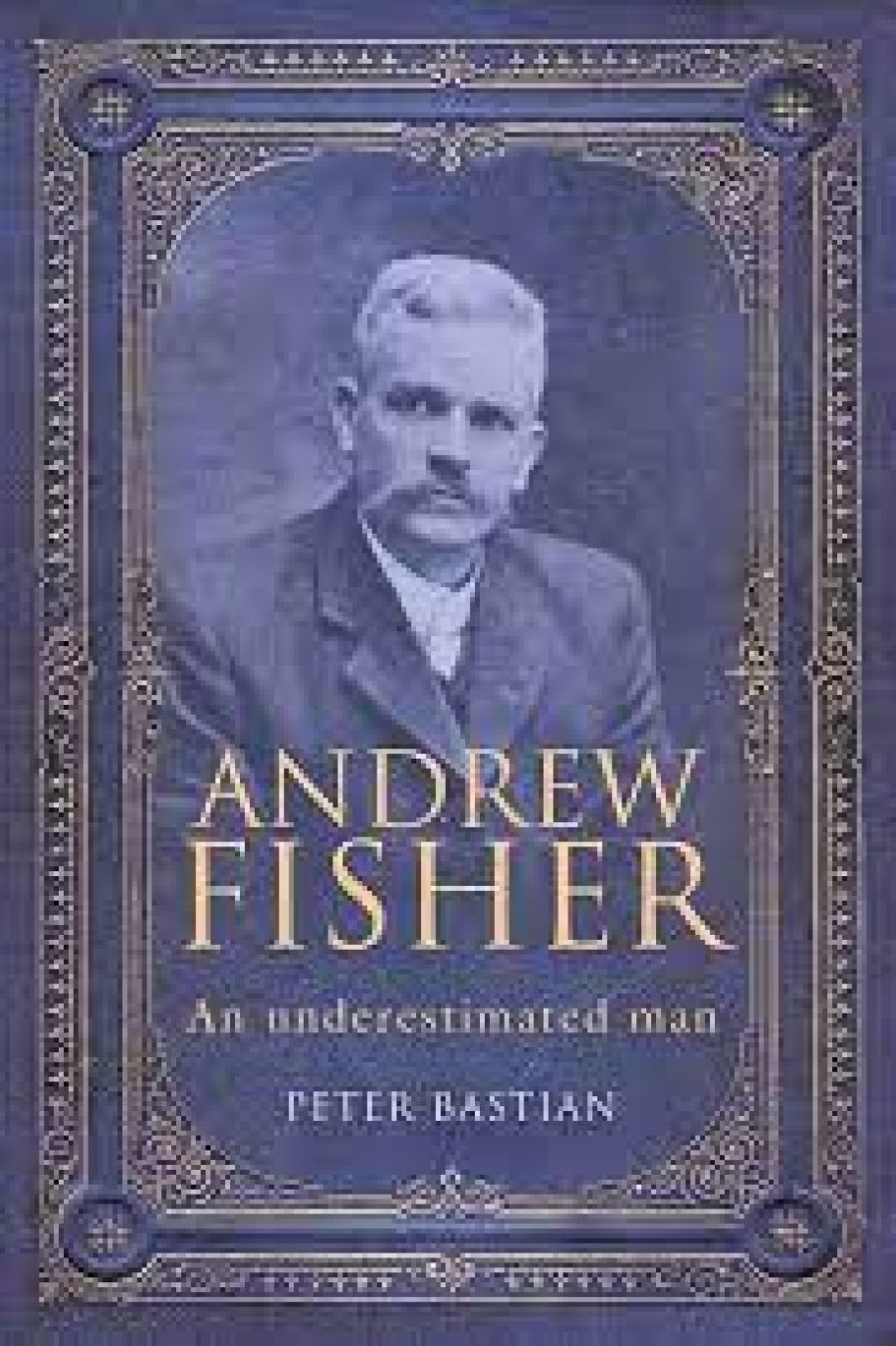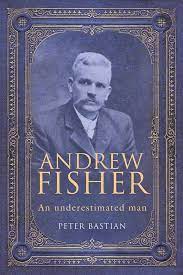
- Free Article: No
- Contents Category: Biography
- Review Article: Yes
- Article Title: Andy, come up!
- Online Only: No
- Custom Highlight Text:
Andrew Fisher fares well in the new Museum of Australian Democracy, at Old Parliament House, Canberra. The entrance to the galleries is framed, on one side, by E. Phillips Fox’s dark 1913 portrait of an imposing and resolute Fisher, in contrast to the garish, spreading corpulence of George Lambert’s 1924 Sir George Reid on the other. Inside, in the procession of prime ministers, Fisher is represented more comprehensively and intimately than his peers. There is his miner’s crib – for this leader of Australia’s first majority Labor government definitely came from the working class – and his fountain pen, presented by his granddaughter to Kevin Rudd (who, the caption reads, is a ‘passionate admirer’ of his Queensland predecessor). Elsewhere in the Museum, in commemorating the suffrage movement, the key exhibit is a replica of the hat worn by Fisher’s wife, Margaret, when she marched beside Vida Goldstein in a London protest for women’s franchise in 1911.
- Book 1 Title: Andrew Fisher
- Book 1 Subtitle: An underestimated man
- Book 1 Biblio: University of New South Wales Press, $49.95 hb, 419 pp, 9781742230047
- Book 1 Cover Small (400 x 600):

- Book 1 Cover (800 x 1200):

Fisher, it might seem, has a secure place in Australia’s political history. Here, within a year, as if to prove the point, is his second full biography. Peter Bastian’s commitment to reclaim the importance of ‘an underestimated man’ follows quickly on David Day’s Andrew Fisher: Prime Minister of Australia (2008), with both authors seeking to revive awareness of this hitherto unacknowledged ‘nation-builder’. If only coincidence, it is hard not to wonder why this figure – stubborn, dour but decent, shrewd and visionary – has found sudden favour.
I reviewed Day’s biography for ABR in December 2008–January 2009; in taking up Bastian’s study, comparisons inevitably come to mind. These are very different books. Day sought to capture Fisher’s personality as a man of principle who achieved much within an admittedly pragmatic ambit of early twentieth-century socialism (‘We are all socialists now’, Fisher proclaimed in 1908) before the deep compromises of World War I and the encroachment of senility engulfed him as an increasingly irrelevant high commissioner in London.
There is little of this tragic cast to Bastian’s account. His is a detailed political chronology, overtly driven by an evaluative reflex. Bastian weighs those areas in which Fisher can be criticised (leaving Australia in 1915, for example, with his pledge to stand by Britain ‘to the last man and the last shilling’ hanging as rhetoric to be tested) against his undoubted achievements in consolidating the institutional and policy framework of a new nation. Day’s was a biography of experience and identity: Fisher as the ‘White Champion’ of a new and ostensibly pure Australia. Bastian’s is one of measurement and legacy. James Scullin would long recall a cartoon from the Australian Worker after Fisher was elected prime minister in 1910 (the second of three times he held the office), in which Australia, leaning over a mineshaft, beckons, ‘Andy, come up, your country needs you’. Bastian has set out to demonstrate how and why.
The sometimes relentless emphasis on re-estimation means that Bastian is strong on context, drawing the frames within which Fisher should be judged as leader. Where the sentiments of Robbie Burns ran like a refrain through Day’s portrayal, tracing the interior life bestowed by an Ayrshire youth, Bastian establishes the external ‘political cultures’ (a favoured term) shaping Fisher’s politics: the radicalism of Scottish Covenanters; the communal orientation of stern Presbyterianism; Henry George and the fundamental divide between the ‘working’ and ‘speculating’ classes. Defined by these influences, Fisher is by nature ‘uneasy with intellectual speculation’ and becomes for Bastian a moral as much as ideological figure, charting the right and the wrong as they informed the labour movement Fisher actively shaped into a ‘people’s party’. Fisher stands firmly by caucus rule, for example, comfortable in the masculine collegiality of the party room than in the more educated company of reformist ‘inner circles’. Where Day worried defensively at Fisher’s potent espousal of racial exclusion, Bastian notes only that in elections Fisher ‘played the race card very well’. Equally, where Day sees Fisher’s engagement in the ‘Dreadnought Crisis’ over the priorities in Australian naval investment as a test of nationalism, Bastian provides an extended essay on the strategic and budgetary challenges to imperial defence.
In a book that is usually broken by sub-headings every second page, Bastian’s Fisher is caught in snapshots of place and time, episodes in cumulative assessment. A mid-career ‘portrait’, divided into ‘dress’, ‘speech’, ‘dignity’ and so on, offers an engaging, almost ethnographic study of the leader, alert to the boundaries he defined at that moment as the broad-shouldered, straight-backed, proud but sentimental miner turned prime minister. This chronicling mode underpins the contrasts Bastian wants to draw: ‘when Fisher assumed office in 1910 Australia was without a national capital, a national currency, a national public bank, a Commonwealth railway service, and interstate commission or federal territories’ – all soon to change. It informs the book’s main argument: that Fisher’s 1910 election, ending all prospect of an honourable partnership with Deakin’s Liberals, decisively marked a transition in Australian politics between a colonial and a parliamentary culture, not least in the entrenchment of a polarised party system which ‘changed forever the way Australians would think about the social aspirations of their democracy’.
With 1910 as this study’s axle, Bastian portrays Fisher as an astute politician, thriving in parliamentary process, vetting legislation, acquiring knowledge, travelling extensively, envisaging a transformed national and natural environment. This approach, however, fosters a fragmented narrative, strong on issues, thinner on relationships. Malcolm Shepherd, the close, critical observer of Fisher’s personal strains in office – the prevarications, temper and awkwardness in public speaking – is quoted for over thirty pages before being identified as his private secretary. Within three pages, two distinct ‘watersheds’ – a downfall and an election – are detected. Points of interpretation that could elucidate personality are compressed into opaque sociologese: ‘The decision to live in Melbourne also meant that the Fishers escaped from the expectations of a certain social position often consigned to people in a country town.’
If Day’s analysis was shadowed by intimations of Fisher’s dementia, almost as a testament to the passing of the world he represented, Bastian almost euphemistically avoids such diagnosis for as long as possible. Even in Fisher’s decline as high commissioner Bastain catalogues the minute scrutiny of inefficiencies at Australia House, London, and allows conscription – the issue which was Day’s alternative axis – to be no large leap for many already supporting universal military training. In these last sections, Bastian oscillates between regretting the ‘steadfast leadership’ that Fisher might have offered if he had not given place to Billy Hughes as wartime leader, and the rather anachronistically identified ‘weakness’ he had bequeathed in not allowing his commitment to social reforms such as maternity allowances to expand into ‘a comprehensive welfare state’. Biography of achievement here becomes a lean tally, thorough and reliable but begging questions of significance.
Which brings us back to the question: does anything more than coincidence, a sense of ‘Fisher’s turn’, explain these two recent studies? No doubt, as Bastian argues, Fisher’s fall into ‘historical obscurity’ needs correction. Even in his lifetime Fisher was underestimated, not least because of his technocratic and institutional leanings. We certainly need an Australian political biography that can engage imaginatively with more than the flux of politics alone. And there are, Bastian suggests, no great Labor myths or wounds to be rehearsed in Fisher’s life: no demonised Hughes, no tortured Curtin, no trounced Chifley. Nor are the broad dimensions of personality and ‘liberalism’ that bring Deakin repeatedly back into the canon of Australian leaders. Into the 1920s there was some hope that Fisher might again ‘offer himself’ for political office. As the Sydney Morning Herald reported in 1921, he could provide an alternative to the ‘sordid bargains and squalid intrigues of political pygmies’. But he was not wanted, and his decline continued until his death in London in 1928.
With miner’s crib and fountain pen, and the purplish flounce of his wife’s suffragist hat, Fisher comes back to us now as a leader who had a disarmingly simple sense of honour, who shaped the political system we now have but who gives hints of a world of work, causes and solidarities prior to and beyond it. Perhaps that is why he has now ‘come up’ again.


Comments powered by CComment